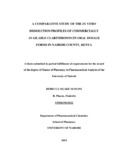| dc.description.abstract | Clarithromycin (6-O-methylerythromycin A) is a semi-synthetic macrolide derived from
erythromycin A. It has improved acid stability, higher oral bioavailability and less
gastrointestinal side effects than the naturally occurring macrolides. It is indicated in the
treatment of upper respiratory tract infections due to Streptococcus pyogenes, Haemophilus
influenzae, Streptococcus pneumoniae, Haemophilus parainfluenzae, Mycoplasma
pneumoniae and Chlamydia pneumoniae. It is effective against skin infections due to
Staphylococcus aureus and Streptococcus pyogenes. It is also used in the treatment of
disseminated mycobacterial infections due to Mycobacterium avium and Mycobacterium
intracellulare. It forms the cornerstone of treatment of MAC infections in HIV-AIDS and is
an important component of triple therapy regimens for eradication of H. pylori in peptic ulcer
disease and chronic gastritis.
Despite its improved acid stability compared to erythromycin, clarithromycin undergoes
degradation to microbiologically inactive products when subjected to acidic conditions and
low gastric pH. It also has poor aqueous solubility that is pH-dependent and a dissolution
rate-limited absorption.
In the present study, a comparative dissolution profiling of oral clarithromycin products in
Nairobi County, Kenya was carried out with a view to determining its stability in dissolution
media of varying pH values. For this reason, dissolution profile tests were carried out at pH
1.2, 4.5 and 6.8 in order to mimic gastric and intestinal conditions. The tests were run for 60
and 90 minutes for clarithromycin tablets and suspensions respectively. The study was aimed
at determining the pharmaceutical equivalence of generic clarithromycin oral preparations to
the innovator products.
All products tested complied with pharmacopoeial assay specifications. They also complied
with single-point dissolution specifications. However, significant differences were observed
in their dissolution profiles. At pH 1.2, 50% (six out of twelve) of tablet products failed to
meet the specifications for similarity factor in relation to the innovator product. At pH 4.5,
33% (four out of twelve) of tablet products were non-compliant while 50% non-compliance
was noted at pH 6.8 with six out of the twelve tablet products failing to meet the
specifications. None of the suspensions tested met the requirement for similarity factor in
relation to the innovator suspension. Overall, only 25% (four out of sixteen) of all products
tested complied with the specifications for similarity factor in relation to the innovator
products.
The equivalence patterns observed in this study indicate that assay and single-point
dissolution tests are not sufficient to demonstrate pharmaceutical equivalence between
innovator products and their generic equivalents. As a minimum requirement, it would be
necessary to carry out comparative dissolution profiling of generic products in order for them
to be certified as interchangeable with the innovator products. | en_US |
| dc.description.department | a
Department of Psychiatry, University of Nairobi, ; bDepartment of Mental Health, School of Medicine,
Moi University, Eldoret, Kenya | |

